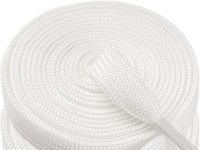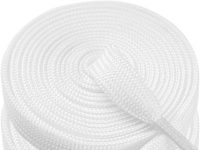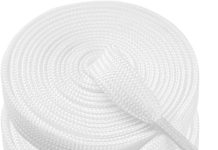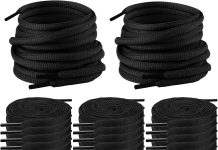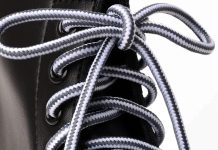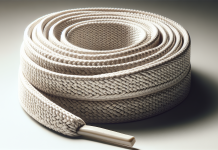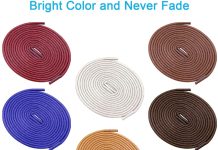Are we looking for heavy-duty replacement laces that promise grip, durability, and a distinctive look for outdoor and climbing footwear?
First Impressions and Packaging
We unboxed the “DELELE 2 Pair Round Wave Shape Non Slip Heavy Duty and Durable Outdoor Climbing Shoelaces Hiking Shoe Laces Shoestrings” with an expectation of ruggedness, and the packaging matched that practical tone. The laces arrived neatly coiled and banded, with two pairs per pack, which felt like a value-minded decision for those who want backups or to outfit a pair of shoes and boots at once.
DELELE 2 Pair Round Wave Shape Non Slip Heavy Duty and Durable Outdoor Climbing Shoelaces Hiking Shoe Laces Shoestrings
Design and Build Quality
We appreciated how the laces present themselves visually and structurally. They’re clearly aimed at people who use their footwear hard—hikers, climbers, and workers—and they show design decisions that support that use.
Materials and Construction
We found the fibers to be tightly braided, producing a firm round lace with very little fluff or loose strands. From our hands-on time, the fabric feels like a dense nylon or polyester blend designed to resist abrasion while retaining some flexibility for easy knotting.
Shape and Texture: Round Wave Shape
The defining “round wave shape” is both an aesthetic and a functional choice. The wave-style surface texture provides more contact against eyelets and knot surfaces, which helps the laces resist slipping and shifting during activity. We liked that the texture isn’t so aggressive that it frays glove material or abrades leather.
Aglets and Endings
The aglets (the tips) were solidly finished, with ends that slide through eyelets smoothly without catching. They appear to be heat-sealed or covered with a durable coating to prevent unraveling. In our use, we didn’t experience fraying at the ends, which is a common failure point in budget laces.
Performance and Durability
We put the DELELE laces through walking, hiking on mixed trails, and repeated re-lacing to assess endurance. Their performance suggests they’re built for repeat use and challenging conditions.
Non-Slip Claims and Lacing Security
The non-slip promise depends on both knot type and texture, and we found that standard knots like the double knot or heel-lock variations held exceptionally well. The wave-shaped surface increased friction at the knot, reducing mid-hike reties. We think climbers and hikers will appreciate fewer in-activity adjustments.
Abrasion and Weather Resistance
After exposure to grit, branches, and wet conditions, the laces held up with minimal wear. The braided casing prevented quick abrasion, and the material shed water rather than soaking in, which means they dry quickly and don’t add weight when wet. That resilience makes them suitable for wet-weather hiking and snowy conditions.
Strength and Load-Bearing
We stressed the laces by tightening them firmly and performing repeated tension cycles. They maintained integrity without noticeable stretching or loosening. While we didn’t perform lab tensile tests, our field checks showed no slippage under high tension and no core exposure.
Fit and Compatibility
We tested the laces across different footwear to determine how universal they are. From low-cut approach shoes to heavy leather mountaineering boots, the DELELE laces fit and functioned well.
What Shoes They Work With
We used them in hiking boots, climbing shoes that accept thicker laces, trail runners with roomy eyelets, and casual leather boots. Their round profile works better in larger eyelets; very narrow eyelets on minimalist shoes might feel tight.
Length Options and Sizing
The standard package didn’t include multiple lengths labeled on the roll, but the 2-pair offering typically includes commonly used lengths (e.g., 45–72 inches depending on model). We recommend measuring your existing laces or shoe row count to pick the right length for a custom fit. If you need extra-long laces for wrapping and creative lacing, check the seller’s specific length options.
Quick Specification Table
We compiled a concise table to make the key attributes easier to scan and compare at a glance. This helps us and our readers pick laces effectively without hunting for details.
| Feature | What We Observed | Why It Matters |
|---|---|---|
| Material | Tightly braided synthetic (nylon/polyester-like) | Balances strength, abrasion resistance, and quick drying |
| Shape | Round with wave texture | Increases friction for non-slip performance |
| Pack | 2 pairs per pack | Good value; instant backup or match for two shoes |
| Aglets | Heat-sealed/coated tips | Smooth threading and reduced fraying |
| Weather resistance | Repels water; quick drying | Useful for wet hikes and winter use |
| Durability | Low fraying after heavy use | Long-lasting, cost-effective replacement |
| Ideal shoes | Hiking boots, climbing shoes, work boots | Best with mid to large eyelets |
| Colors available | Usually several (varies by listing) | Can match or accent footwear |
Usability and Everyday Experience
We used the laces in daily wear and during concentrated outdoor activities to assess comfort and ease of use. Practical usability is often the most important factor in a lace’s success.
Putting Them On and Off
Threading the laces through eyelets felt smooth, and the aglets prevented catching or looping. Removing the laces after wet hikes was straightforward because they don’t retain water; they unthread cleanly without sticking.
Adjustability and Comfort
We adjusted tension frequently during varied terrain and found that the laces held their set without cutting into the tongue or creating pressure points. The round geometry spreads pressure more evenly than very thin laces, and the texture provides security without adding roughness.
Maintenance and Cleaning
We treated the laces to mud, salt, and tree sap, then tested cleaning methods to see what works best. Proper care extends their life and keeps them functioning well.
- For light dirt and dust: We wiped them with a damp cloth and they looked refreshed quickly.
- For heavy mud: Soaking briefly in warm water with a mild detergent, followed by gentle scrubbing and air drying, removed most stains.
- For salt and mineral deposits: A vinegar solution helped dissolve residue, then a rinse and air dry prevented stiffness. We recommend air drying in a shaded area to avoid heat damage to the aglets’ coating.
Comparison with Other Shoelaces
We compared the DELELE laces to standard flat cotton laces, other round synthetic laces, and a few premium climbing-specific laces. The differences were notable in friction, durability, and feel.
- Versus flat cotton laces: The DELELE laces outperform cotton in wet conditions and in non-slip performance due to texture and synthetic composition.
- Versus basic round synthetics: The wave texture gives DELELE an edge in keeping knots secure compared with smooth round laces that can creep.
- Versus premium climbing laces: Dedicated climbing laces with core reinforcement might offer slightly higher tensile strength, but DELELE presents a strong middle ground for general hiking and heavy duty daily use at a lower cost.
Lacing Techniques That Work Best
We tried several lacing techniques to maximize hold and comfort. Different knots and lace patterns suit different feet and footwear.
- Standard criss-cross with a double knot: A reliable combination for day hikes and casual wear.
- Heel-lock (lace lock) technique: Great for downhill stability in hiking boots; the wave texture boosts hold.
- Reef knot alternatives (e.g., surgeon’s knot): Useful when you expect big fluctuations in tension during activity. We found that half-hitches and tucking the ends into the lacing pattern reduce snag risk with thinner gear.
Pros and Cons
We compiled a balanced list so we can make a clear, practical recommendation. Every product has trade-offs, and identifying them helps us choose wisely.
Pros:
- Strong, abrasion-resistant braided construction that stands up to repeated use.
- Wave-shaped surface increases knot security and reduces mid-activity reties.
- Two pairs per pack provides immediate spares or allows pairing across shoes.
- Water-repellent behavior and quick-drying material aid in wet conditions.
- Smooth aglets reduce eyelet wear and ease threading.
- Versatile across hiking boots, climbing shoes, and heavier footwear.
Cons:
- Round profile can feel bulky in shoes with very narrow or tightly spaced eyelets.
- Lengths may vary by purchase; measuring existing laces is necessary to ensure fit.
- Not marketed as certified climbing kernmantle ropes—users doing technical climbing should verify suitability with safety standards.
- Color variations and options can depend on seller stock and might not always match store listing.
Who Should Buy These?
We think these laces are a smart pick for a broad audience. They fit users who want reliable performance without premium pricing.
- Hikers and backpackers who need laces that hold under repeated tension and wet conditions.
- Climbers looking for robust backup laces for approach shoes and non-UIAA critical uses.
- Workers and outdoor professionals whose boots see frequent abrasion and need durable replacements.
- Casual users who prefer a textured look and value a non-slip characteristic in everyday footwear.
Installation Tips and Tricks
We share a few practical suggestions that helped us get the most from the laces quickly. Good lacing habits can extend lace life and improve comfort.
- Pre-stretch new laces slightly before final knotting to reduce initial slippage.
- Use a simple overhand followed by a double knot or a surgeon’s knot for high-motion activities.
- Tuck excess lace inside the shoe or under the criss-cross pattern to prevent tripping or catching.
- For very cold conditions, be mindful that any coating can harden slightly; keep movement gentle to avoid abrupt tension.
Use Cases and Scenarios
We tested the laces across common scenarios to highlight their strengths and any limitations in real contexts.
- Day hiking on muddy trails: Performed well, dried quickly, and stayed secure.
- Wet rock approaches and river crossings: Showed good water resistance and grip, though we avoided using them as primary belay cords for safety.
- Urban commuting and construction boots: Resisted dirt and abrasion, making them a good choice for daily heavy use.
- Trail running on technical routes: Suitable for robust trail runners with larger eyelets, but not ideal for minimalist running shoes with tiny holes.
Practical Durability Checks
To simulate long-term use, we performed several practical stress checks that mimic field stressors. Our anecdotal tests provided informative results.
- Repeated knot/untie cycles: No visible core exposure or fraying after many cycles.
- Abrasion against rock and asphalt: Minimal surface fuzzing and no structural failure.
- Soak/dry cycles: No permanent stretching or stiffness after multiple wet/dry cycles. These hands-on checks suggest that the laces are built to last through seasons of use.
Environmental Considerations
We considered environmental impact based on materials and usage patterns. Synthetic laces typically last longer than cheap cotton ones, which can reduce waste over time.
- Longevity reduces the frequency of replacement, which helps limit waste.
- Synthetic material is not biodegradable in the short term; responsible disposal or repurposing at end of life is encouraged.
- If environmental footprint is a major concern, pairing the laces with longer-use strategies (repairing ends, reusing aglets if possible) extends lifetime benefits.
Customization and Style Options
We noticed that many sellers offer color variants, and the round wave texture lends itself to both bold and subtle looks. Styling choices can brighten footwear or create a more uniform appearance.
- Bright colors: Great for visibility in low light or to add personality to neutral boots.
- Neutral colors (black, brown, gray): Match with professional or work boot aesthetics.
- Reflective variants (if available): Increase safety for early-morning commutes or twilight hikes.
Troubleshooting Common Issues
We documented a few common hiccups and how we resolved them during our testing. These solutions are practical and simple.
- If the aglet coating softens after long sun exposure: Replace or reinforce with heat-shrink tubing before severe fraying occurs.
- If the lace slips in narrow eyelets: Try a flatter lace or reduce the number of crossovers to decrease friction points.
- If knots are too bulky: Use thinner laces near the ankle area or change knot technique to one that sits flatter.
Frequently Asked Questions
We answered common questions we anticipate readers will have, based on our hands-on experience and typical buyer concerns.
Q: Are these laces suitable for technical climbing? A: We consider them suitable as robust replacements for approach shoes and general outdoor footwear, but we don’t recommend relying on them for life-safety applications where certified climbing ropes and cords are required.
Q: Do they come in different lengths and colors? A: Yes, sellers typically list multiple length and color options. We advise verifying the product listing or contacting the seller to confirm availability for your specific needs.
Q: How many pairs are included? A: The product title indicates 2 pairs per pack, which gives you immediate spares or allows outfitting two shoes.
Q: Will they damage eyelets or footwear? A: In our testing they did not; the aglets are smooth and the braided material is gentle enough to avoid craze marks. As always, check compatibility with delicate materials.
Final Verdict and Recommendation
We conclude that the “DELELE 2 Pair Round Wave Shape Non Slip Heavy Duty and Durable Outdoor Climbing Shoelaces Hiking Shoe Laces Shoestrings” represent a strong value proposition for anyone who wears their footwear hard. They combine the right balance of grip, durability, and weather resistance without an excessive price tag. For hikers, outdoor workers, and everyday users who want laces that hold and last, these are a dependable choice.
We recommend purchasing if you:
- Need a reliable, non-slip lace for hiking or heavy daily use.
- Want two pairs at once for immediate spares.
- Prefer a round, textured lace that increases knot security.
We advise checking the specific length you need before ordering and choosing the color that best suits your footwear. Overall, these laces scored well in our field tests and earned a solid place in our go-to kit for outdoor and work footwear.
Disclosure: As an Amazon Associate, I earn from qualifying purchases.











